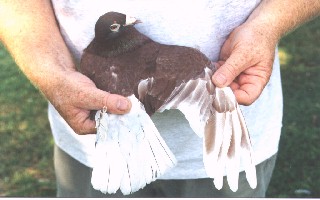
All
plumage color found in our pigeons is produced from one of
two melanic pigments. These two forms of melanic pigments are
eumelanin
and phaeomelanin.
In
the production of these two melanins it is the biochemical
process which decides if you get eumelanin or phaeomelanin
pigment and
this outcome is dependent on an activity ratio between tyrosinase and
tyrosine. A higher ratio of tyrosinase in the biochemical
process results
in eumelanin being produced, while a lower ratio gives
phaeomelanin.
In other words, if you increase the amounts of tyrosinase
you end up
with brown or blue/black eumelanin pigment; while, an increase in
tyrosine
results in red phaeomelanin pigment. The thing that decides
if eumelanin
will result in either a brown or a black pigment depends upon the
completeness
of the oxidation process. When this process is incomplete,
eumelanin
results in brown pigment while a more complete oxidation process yields
black
pigment. On the other hand, phaeomelanin is a reddish brown
pigment and
it is from this pigment, that our birds get their red
color.
Diluted forms of brown eumelanin becomes a khaki color; diluted black
eumelanin
yields a silver dun color; while diluted phaeomelanin gives us our
golden
yellows. Therefore the
three basic color forms we have are brown, blue/black which is the
normal wild
type and ash red. It is the ash red pigment color that is the
most
dominant of the three and ash red is the color form which we
will discuss
here.
Ash
red or dominant red (as it is sometimes referred to) is a
sex-linked mutation, with the genetic symbol BA.
It can be
found in many varied phenotypes from the normal ash red
patterns of
barless, bar, checker and t-pattern velvet to any number of
combinations with
other mutants such as dilute, pale, reduced, rubella, grizzle,
spread,
indigo etc just to name a few. Each of these combinations
will differ in
some color form, yet genetically their base color remains.
Having
said that, I must point out that our pigeons are not
just one form of melamic pigment or the other, rather they are
combination that
is predominantly one form or the other. In other words,
studies show that
varying amounts of both eumelanin and phaeomelanin will exist jointly
in
our birds feathers. Black and brown will be predominantly
eumelanin with
small amounts of phaeomelanin, while ash red will be
predominately
phaeomelanin with small amounts of eumelanin present. This
explains why some
blues will have bronze showing in their otherwise blue/black feathers;
or why
some ash reds will have black ink spots. In the case of many
ash red
cocks, these ink spots often points to their being heterozygous for
both
blue/black and ash red. However their presence being found on
some hens
cannot be explained by a heterozygous condition since these
hens are never
heterozygous for basic color. In their case, and in the case
of some
cocks, these small amounts of black are the result of other factors in
the
pigment production process; mainly the availability or ratio of
tyrosinase /
tyrosine within the cell.

Ash Red Velvet (BA) (CT)
This
Ash Red Velvet is a deep red
color. Some call it Brick Red; a term also used to
describe other
forms of solid reds such as Recessive Red (e) and Indigo Red Velvets
(+), (In),
(CT).
All three of these Red forms are shown on my Other
Reds page. Of these three Red forms, only Ash Red is a true
color.
The others, all result from a pattern and or modifying genes producing
a change
to the basic color and result in a bird that appears to be
red. In
the case of recessive red (e) it could be any true color with any
pattern. Indigo Red velvet (+), (In), (CT)
,however; is
only formed by combining the color blue (+) with the modifier for
Indigo (In)
and the pattern called t-pattern checker or velvet (CT).
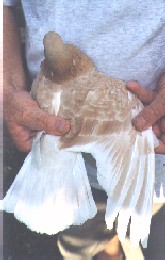
This
Yellow Check hen
is simply an Ash Red with the Dilute gene modifying her color into a
lovely
golden yellow (BA);
(d); (C)//(C). Pigeons which display
this modifying gene known as Dilute (d) are born
naked. They will
not have any yellow down fuzz. Since the gene is sex linked,
a cock bird must be
homozygous (carrying two genes) for dilute to show any effect for
color. Hens can only possess this gene
once. When they
do it is displayed.
Some more Ash Reds - a Mealy, a Check, a Strawberry and a Grizzle
An
Ash Red Mealy (BA),
(C+)
is the bared pattern form of
this color. A Red Check is the checker pattern
while Strawberry is
the term used to describe the modifier known as sooty or what many
Americans
mistakenly call pencil. Spread Ash is the spread
form and is not red
but creamy ash in color. Ash Red Grizzle is more white than
red but their
red color is seen in the form of a few red specks or
feathers. A
double dose (homozygous) of the grizzle gene will produce a nearly all
white
bird with ivory bill and colored eyes.
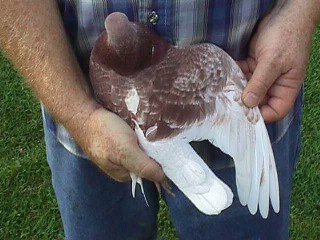
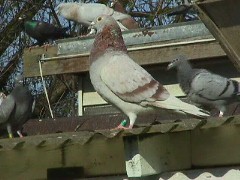
Ash
Red Check pattern (BA),
(C) on the left and a Mealy - Ash Red Bar pattern (BA);
(C+)
on the right.
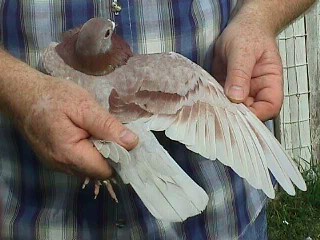
Strawberry
- Ash Red Sooty pattern. Notice
how the Sooty gene has also darkened the ash color of the wings and
tail.
Compare this to the red check above which does not carry Sooty. (BA),
(C+),
(So).
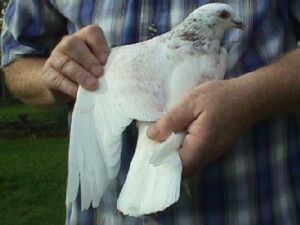
Next Page - The Pattern Series
Email: